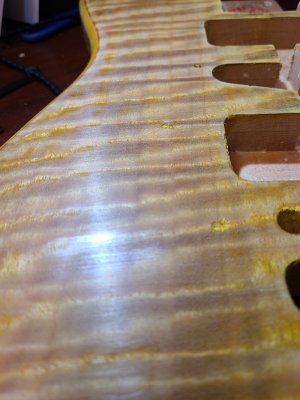NedRyerson
Senior Member
- Messages
- 779
I bought a junky body off of Reverb (again, dangerous place) with a quilted maple top. Seller was up front and honest, saying the thing needed a TON of work to get it remotely decent. I went in with no illusions as to its condition.
The lam top has a noticeable texture. It's not the illusion of texture, as I understood quilted maple to have, but actual texture. Is that normal for QM or could that be the result of environment, manufacture, none of the above, all of the above?
I'm fairly confident that if I put in the elbow grease over a long period of time, I could rehab it into something lovely. I was just curious about the characteristics and behavior of woods (still learning over here) to set my expectations to a reasonable level.
The lam top has a noticeable texture. It's not the illusion of texture, as I understood quilted maple to have, but actual texture. Is that normal for QM or could that be the result of environment, manufacture, none of the above, all of the above?
I'm fairly confident that if I put in the elbow grease over a long period of time, I could rehab it into something lovely. I was just curious about the characteristics and behavior of woods (still learning over here) to set my expectations to a reasonable level.



